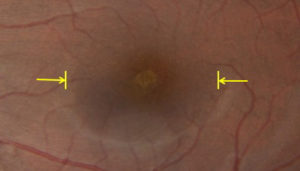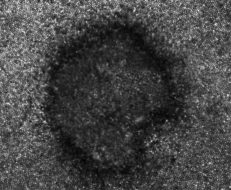For a young woman who stared too long on August 21st, the partially eclipsed Sun left a lasting impression — on her retinas.

The JAMA Network
When the much-anticipated Great American Eclipse finally arrived last August 21st, eager skygazers across the U.S. were prepared and ready. Thanks to an unprecedented public-safety campaign, an estimated 100 million "eclipse shades" (virtually all of them certified as safe) had been distributed to the public via schools, libraries, and online sales.
But apparently not everyone was able to prevent eclipse-related eye damage. A report in JAMA Ophthalmology published online December 7th recounts the case of a 26-year-old woman from New York City who glanced at the mostly eclipsed Sun several times directly with her eyes, as well as through borrowed viewing glasses that weren't safe enough. (At the eclipse's peak in the Big Apple, 28% of the solar disk was still visible.)
Four hours later, the young woman started experiencing blurred and distorted vision. The symptoms were worse — accompanied by a central black spot — in her left eye. She checked in with ophthalmologists at Mount Sinai Hospital in New York City, who found a yellow-white spot on the left eye's fovea. Then the team used state-of-the-art techniques, including adaptive optics scanning light ophthalmoscopy, to examine the retinal damage at the cellular level.

The JAMA Network
“We have never seen the cellular damage from an eclipse because this event rarely happens and we haven’t had this type of advanced technology to examine solar retinopathy until recently,” said lead investigator Avnish Deobhakta, an assistant professor of ophthalmology at the Icahn School of Medicine at Mount Sinai, in a press release from the hospital.
Sunlight-induced retinopathy is usually temporary, and the eyes recover completely. But in this case the patient's symptoms were still present six weeks after the eclipse, an indication that the damage might be permanent. The Mount Sinai team plans to examine her again early in 2018.
Deobhakta and his colleagues examined 22 people at their urgent-care clinic who were worried about eye damage following the eclipse or had blurred vision. Besides this most severe case, two others experienced some mild changes to their retinas but have since recovered fully.
Ralph Chou (University of Waterloo), an expert on eclipse-related eye damage, estimates from anecdotal reports that fewer than 100 people nationwide reported any sort of eclipse-related vision issues. And while any eye damage due to staring at the Sun is unfortunate (and entirely preventable!), an estimated 215 million people viewed the spectacle — and eclipse organizers are heartened that their safety campaign succeeded so well.
 0
0









Comments
You must be logged in to post a comment.